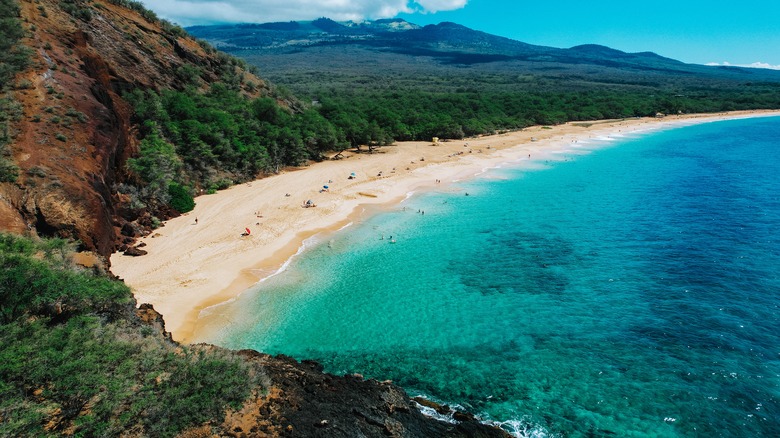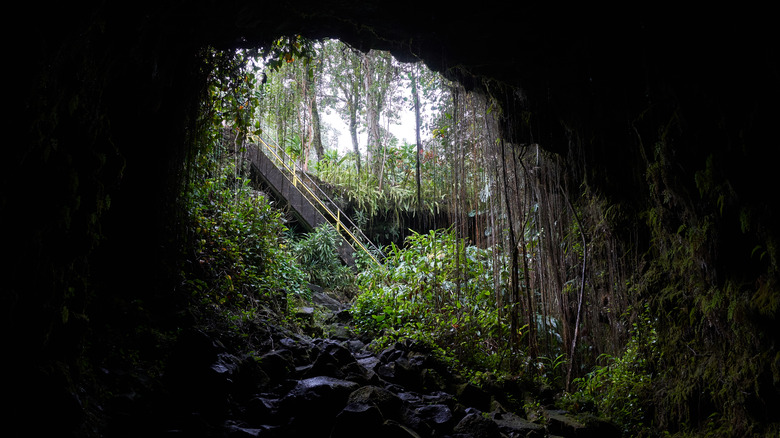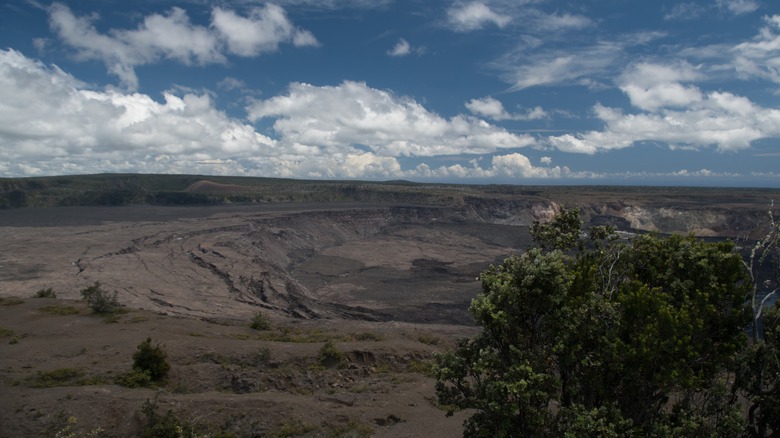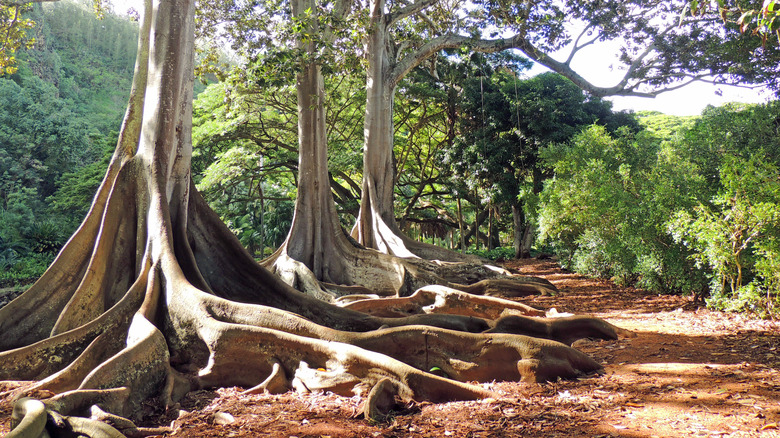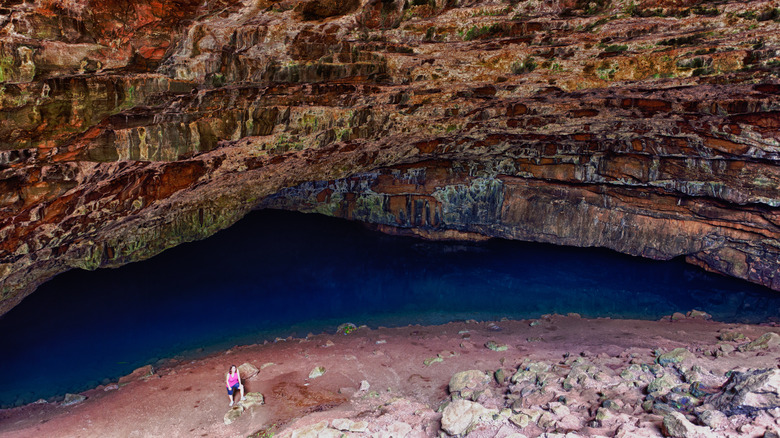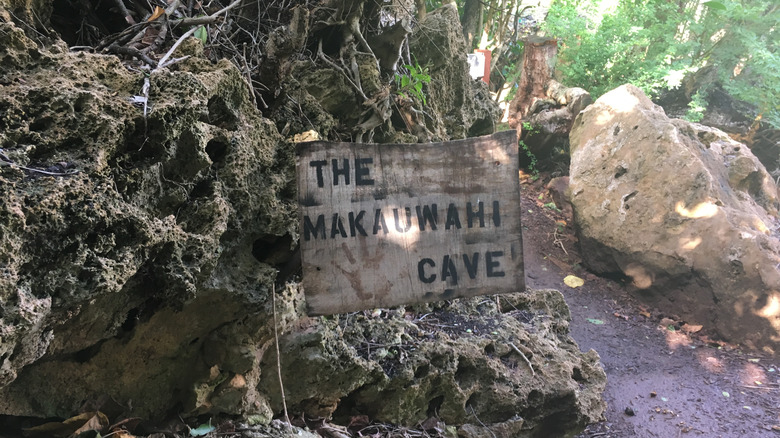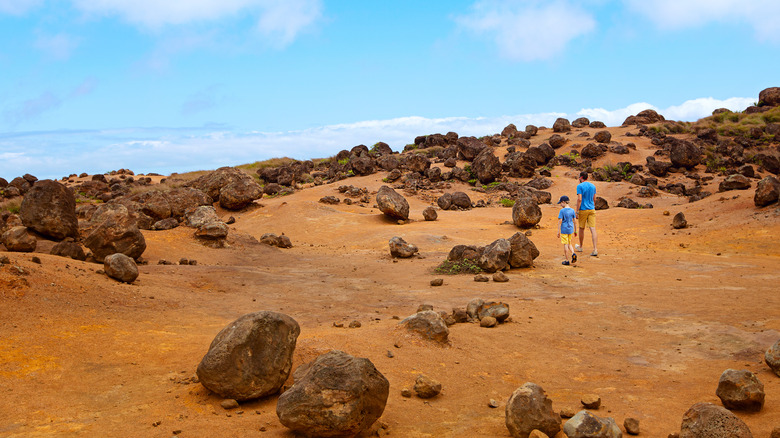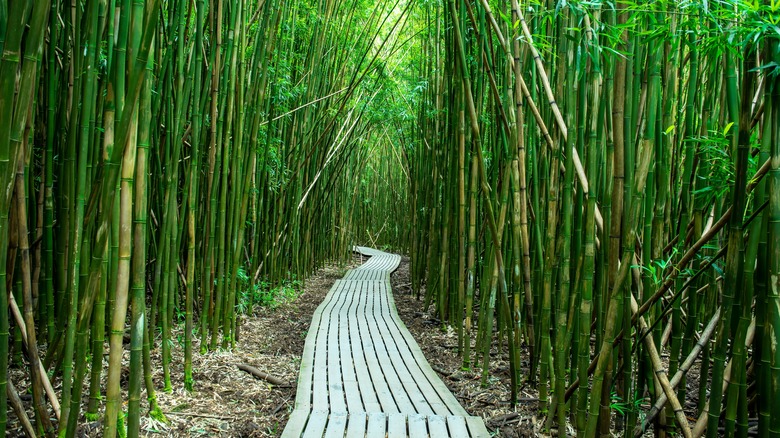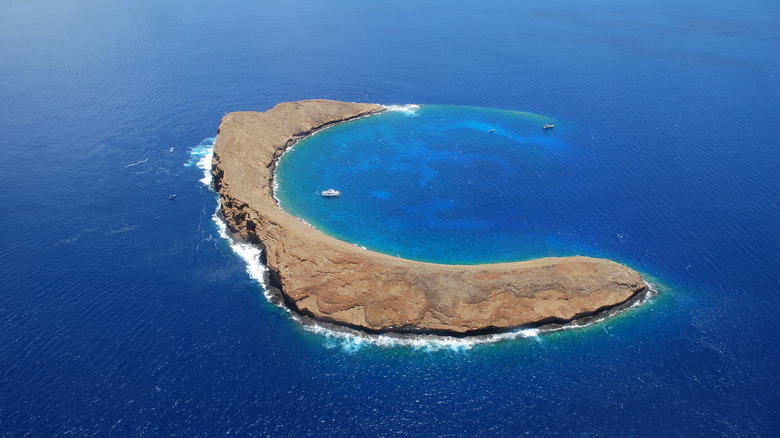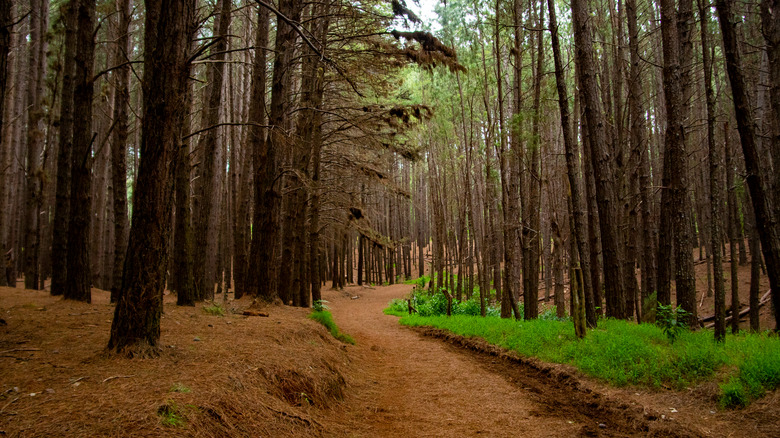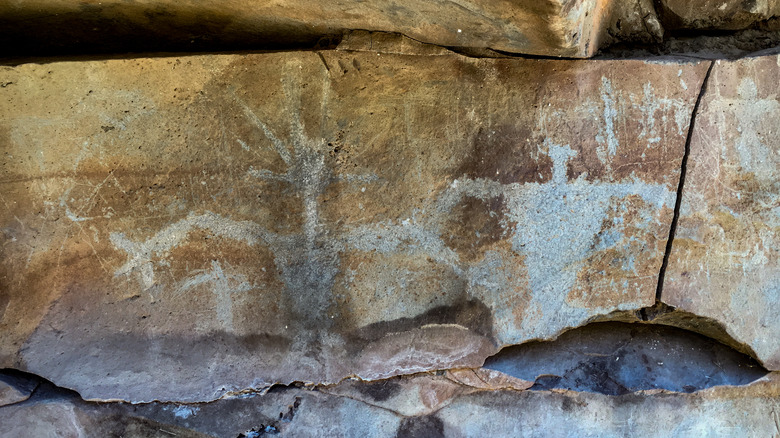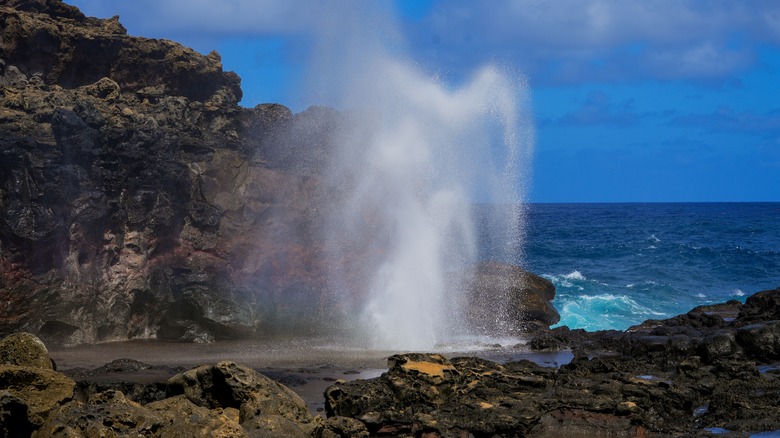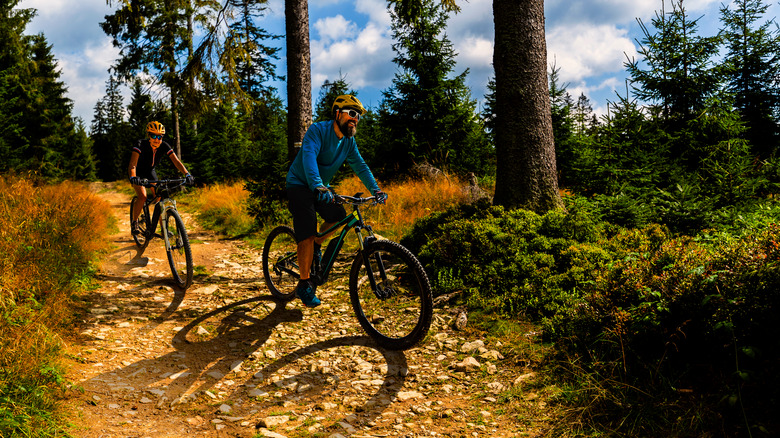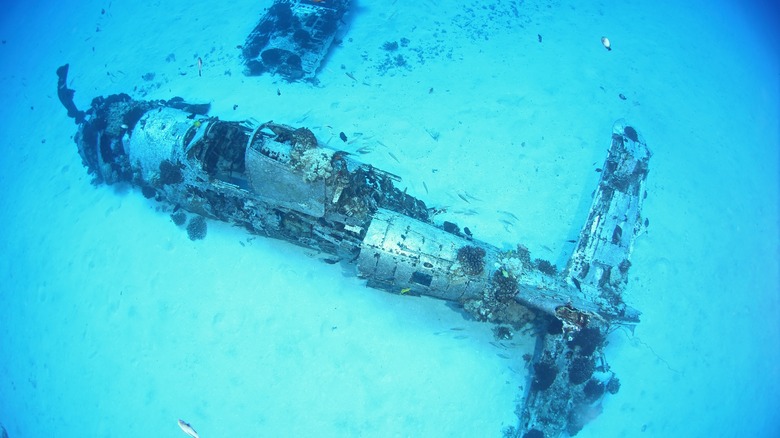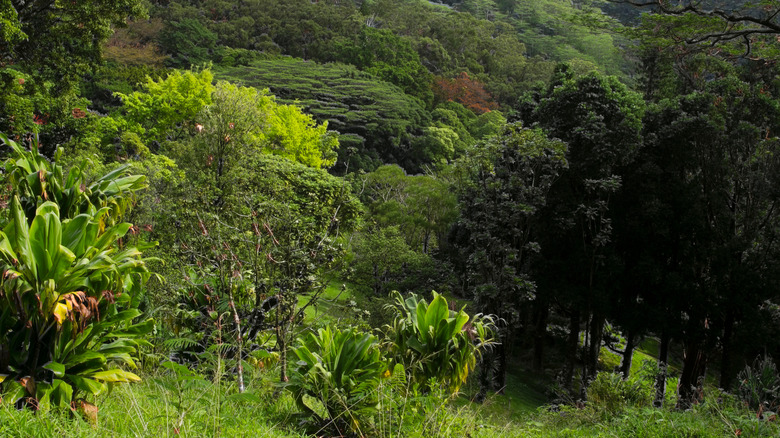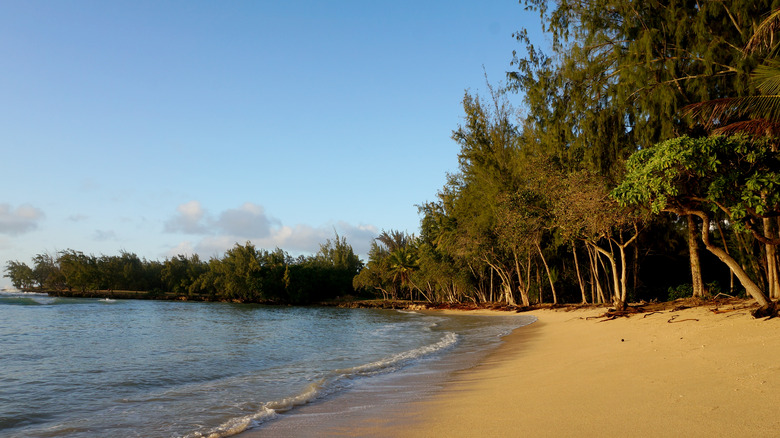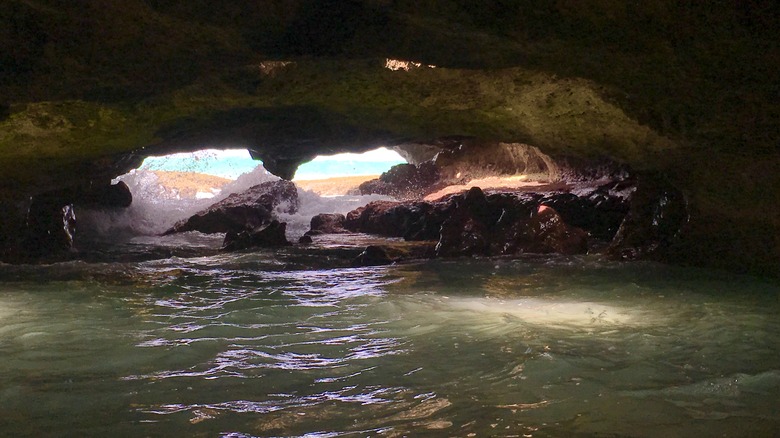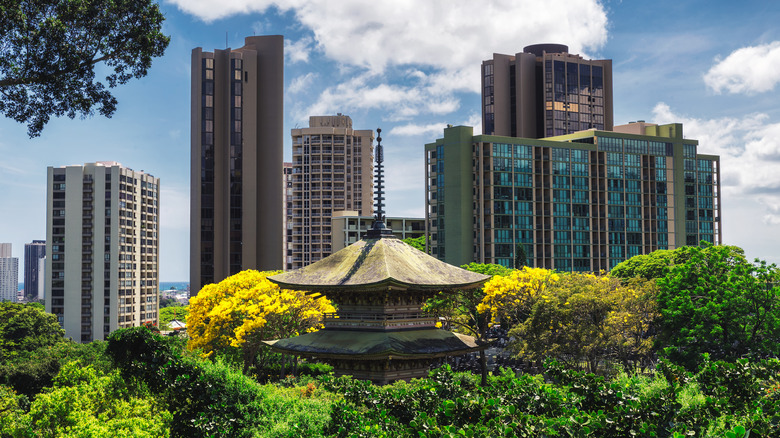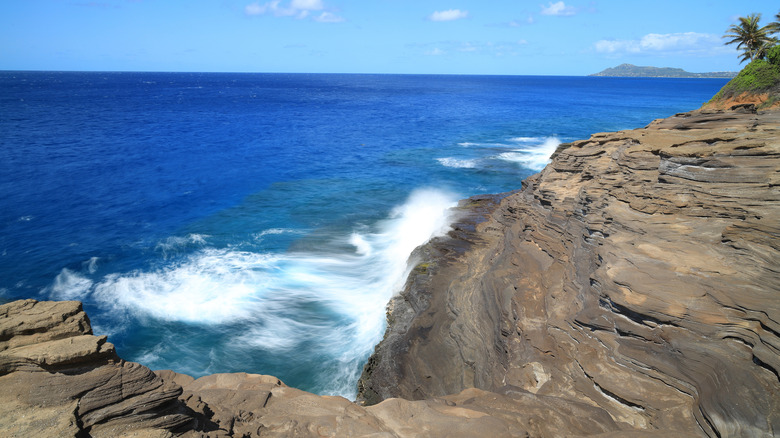Underrated Attractions That Are Missing From Your Hawaii Bucket List
To call Hawaii a tropical paradise would be to express the obvious. The United States' newest and arguably most remote state — it sits more than 2,000 miles off the coast of California — is a playground of lush forests, indented oceanic cliffs, verdant plateaus, craggy lava fields, and active volcanoes. It's no wonder, then, that some of the Jurassic Park movies were shot here, and that the island state has become a huge draw for tourists.
Many of the islands' natural, and manmade wonders have now reached iconic status — here is where to find the sands of Waikiki Beach, the observatory atop the dormant volcano Mauna Kea, the folded slopes of Na Pali Coast State Wilderness Park, and the Memorial for Pearl Harbor. And yet, for every Hana Highway, there remains a part of the state that awaits discovery by travelers. Here are some of those undiscovered gems, arranged by island.
Kaumana Caves State Park, Big Island
After a volcanic eruption near the town of Hilo in the 1880s, lava flowed freely, its molten, searing hot sludge slicing through everything in its path. As the lava effortlessly edged forward, its top layer cooled to form a crust, with the searing sediment venturing forth below. Over time the upper part hardened to create a tube, with the hollow below signifying where the lava had flowed out.
These formations, known as lava tubes, recur throughout Hawaii, and the ones here are easily accessible, and free to enter (the deeper sections of them reside within private property). Getting into the caves requires descending a metal stairwell, and with the humidity, and moss that grow here, conditions can be slippery. Inside the caves, with ferns, plants, and large rocks, it feels so remote that you can imagine playing hide and seek and never being found!
Kau Desert, Big Island
Though this island is officially called Hawaii, it is commonly referred to as the Big Island, a name that relates to its size in comparison to the others of the archipelago. Think of these islands and your mind is likely to conjure up images of lush forests, sensual sands, and blooming flowers. This part of the state, though, presents a stark contrast to the typical geography associated with Hawaii.
Located in Hawaii Volcanoes National Park, home to the restless volcanoes Kīlauea and Mauna Loa and a Unesco World Heritage site, the Kau Desert is arid and desolate, an area of sparse, elemental beauty created by volcanic ash, porous rock, and acid rain derived from volcanic gases here. Most interestingly, the expanse has preserved human footprints in the ash, that, according to one theory, belong to warriors heading journeying through the area in the late 1700s.
Allerton Garden, Kauai
A visit to this garden on the south shore of Kauai is not cheap and must be taken as part of a guided tour, but it's a fabulous special treat. The destination celebrates the combined efforts of an architect, artist, and the Hawaiian queen Emma, who planted rose apples, mangos, pandanus, bamboo, Alexandrian laurel, bougainvillea, and more here.
Anchored by the former home of the wealthy Allerton family, with one-time guests including Jacqueline Kennedy, a visit is especially memorable at sunset, where you will be able to pore over the Allertons' trove of personal items and photos, great artwork, and sculptures. You'll even end the sojourn with a meal overlooking the sun setting into the Pacific. This place's cinematic allure is plain to see once you visit, and perhaps the reason why films such as "Pirates of the Caribbean" have featured its Moreton Bay fig trees in their shoots.
Blue Room, Kauai
The waters around the islands of Hawaii are seductive, though that adjective might actually undersell their magnetism. The water here will mesmerize you, however, it isn't on the ocean, but at a cave inland from Ke'e Beach, on the island's north coast. Officially known as the Waikapalae Wet Cave, it gets its informal name from the brilliant blue hue of the water that glimmers where when hit by sunlight.
The cave was formed when the sea level was higher than now, eroded by the crashing of the waves onto the rock. The cave entrance sits at the base of a cliff, with skinny vines hanging down its face. To access the Blue Room cave, you need to enter the main cave and swim through — the water will be cold but it will be worth the effort, the striking watercolors making you believe you've entered another world.
Makauwahi Cave, Kauai
More cavernous delights await on Kauai at this, the largest limestone cave in the state. Located a few miles from the island's southernmost point, this cave isn't just a striking example of the patient action of erosion, but also an important archaeological site. The dense sediments here, some as deep as 30 feet, have an impressive preservative — all natural! — quality to them, such that the variety of items that have been subsumed have survived for thousands of years.
Here, you'll find fossils of shells and bones, and imprints of seeds and leaves, microscopic samples of pollen and spores, captured for eternity. Among the highlights are the bones of a Talpanas lippa, an extinct duck that couldn't fly. The area around the cave is rich in current life, former farms and quarries that have regenerated into arenas of forest, dunes, and wetland, rippling with local flora and fauna.
Keahiakawelo, Lanai
Like other Polynesian cultures, Hawaiians believe that their existence is connected to everything around them, with elements like the sky and the earth as relevant to the acts of people. This rocky area in the northwest of the small island of Lanai holds deep mythological significance — just look at the other name for the site – Garden of the Gods.
According to legend, two ancient priests from neighboring islands undertook a challenge to see who could keep a fire burning the longest. The Lanai priest, Kawelo, ravaged the area's dry forest to use as fuel, hoping to keep the flames lit, resulting in the desolate landscape visible today. It's an area strewn with rocks of various sizes — some the size of bowling balls, others with the heft of an elephant — that take on an amazing glow as the sun sets. Note, you'll need a four-wheel drive car to get here.
Lanai Cat Sanctuary, Lanai
Even dog lovers might fall for the purring felines at this refuge situated a stone's throw from the island's airport. The genesis of this sanctuary goes back to 2004, when sterilized street cats were kept safe in horse pens. After a few years, this site was opened as the shelter for the furry strays, and as their numbers grew, so did the project's scope, with medical equipment and trained staff joining.
The rescuing of the cats — with more than 1,800 housed since 2014 — has also helped the survival of endangered birds, like the uau and alae keokeo, whose livelihoods were threatened by the feral felines. The program has also succeeded in having more than 1,000 cats adopted. Visitors can drop by every day of the week, hang out and play with the cats, make a donation to the cause, and even sponsor a tabby or two.
Bamboo Forest, Maui
A beautiful piece of nature in the east of Maui, Haleakala National Park is a territory of verdant forests, craggy coastlines, and volcanic monsters. There are many hikes that visitors can take around the park's alpine deserts, shrubs, and sublime coastal sections. A challenging hike is the full-day Keonehe'ehe'e trail, 11 miles in length and that takes in a volcanic crater floor and a deep volcanic pit.
But for some visitors, the top attraction appears on the Pīpīwai Trail, a four-mile walk where you'll stop by a freshwater stream, rich forested tracts, and a pair of waterfalls. Here, the Bamboo Forest opens itself up about a mile in, with boardwalks, rocky paths, and footbridges winding their way through canyons of towering bamboo trees. The place is not just breathtaking for the natural splendor, but also for the serenity that exists here, a true piece of pure peace.
One'uli Beach, Maui
By a headland on the southeast of the island, and across from the offshore Molokini Crater, this black sand beach is a great springboard for snorkeling and diving. It lies by the forested Pu'u Ola'i cinder cone, a volcanic landmark with a crater on top that is a prominent feature visible from along the coast. The name of the beach translates to black sand, with the finely ground lava formed by the ocean's erosion of the volcanic dome.
It's a wondrous sight, the contrast of black against the ravishing blue sea, and at the water's edge the sand transforms to hardened lava, making for a rocky entry. The snorkeling is fantastic, with coral reefs nearby and plenty of marine treasures therein. Even better, take a trip to Molokini Crater, a half-submerged volcanic crater rim where snorkelers can swim calm seas to see plenty of underwater life.
Redwood Trail, Maui
A little inland from One'uli Beach, Polipoli Spring State Recreation Area may be closed through the end of March 2023, but it's worth waiting for it to reopen to visit this picturesque track. The Redwood Trail isn't long, clocking in at under two miles and dropping by an elevation of 900 feet, making it an easy walk.
The trail begins at a height of 6,200 feet above sea level, an altitude where morning fog and mist is commonplace, and gradually, as it weaves its way past rows and rows of giant redwoods and conifers, it trickles down to a former ranger's cabin. Take time to crane your neck upwards, to see the tops of the trees, and you'll be awestruck by their size. At the trail end, you can join other walks like the Plum Trail and Boundary Trail that, when taken together, form a large loop hike.
Olowalu Petroglyphs, Maui
Named for an area in northwest Maui where they are found, these petroglyphs are easy to reach, a short distance from Olowalu Beach. Getting here requires a quick drive down a dirt track off the main road, or a leisurely walk is just as effective. The drawings, about 100 or so images, are located on basalt rocks, illustrations of human, boats, and animals rudimentarily carved onto the rock faces.
The site is free to enter, and while there were wooden steps and a viewing platform here in years past, these have fallen into disrepair, and graffiti has appeared on some drawings. But don't let this deter you, the drawings are magnificent, sometimes merging with the seams and veins of the rocks, simple sketches etched into hard, elevated surfaces that make you wonder how the artists managed to create them. Visitors should avoid touching these snapshots of history.
Nakalele Blowhole, Maui
The ocean is a remarkable force, an unremitting generator that propels water across vast expanses of the planet. That power is even more impressive when funneled through lava, as it is here, at a blowhole near the northern tip of Maui. Getting to this natural phenomenon necessitates a hike through rocky, windswept terrain. Along the way, travelers will pass sharp, indented cliffs, and an area of rocks eroded by salt water and wind.
Out at Nakalele Point, the blowhole is a jet of water that shoots out from a hole in the ground below, fed by the surging ocean. High tide is the best viewing window, with sprays reaching 50 feet in the air. The unforgettable sight is also fraught with danger — stand well back from the water, its hypnotic power can draw you in, while its physical force can knock you over and pull you into the current.
Makawao Forest Reserve, Maui
In the central north of the island, this area of nature promises an amazing excursion for outdoors enthusiasts. Sitting a few thousand feet about sea level, the elevated region has spectacular flora, and open views of the island and the ocean. The real appeal is the mountain biking, with trails branching off from the parking area, riddled with features like insanely bumpy tracks, jumps, rocky ledge drops, ridges and ripples created by tree roots, and log obstacles. Travelers can also explore the area without wheels on the Kahakapao Trail Loop.
Extending almost six miles, the mildly challenging walk takes in native plants and trees as it curls its way through the high-country forest, the cool climes making it a good spot for a hike. This is a great way to see another side of the island, one where the coast and the water aren't the focus.
Corsair Plane Wreck, Oahu
Divers will tell you that venturing beneath the water is to enter a foreign ecosystem that lives and thrives. But dives are also a way for us to establish a connection to the past. The latter is what you will experience at this dive off the coast of Oahu. Suitable for advanced divers, this plunge descends to a plane that crashed in the blue waters here in 1964, into the depths of Maunalua Bay.
Beached at the bottom of the bay, at a depth of more than 100 feet, the vessels sits in clear blue water. While its deep location means that bottom time is limited, the chance to see this wreck is a unique thrill, to trace its fuselage, hover above a wing submerged in the sand, see the frame of the cockpit, and track the snappers and other fish that call this place home.
Lyon Arboretum, Oahu
A botanic garden open to the public, this domain of gorgeous plants is actually part of the University of Hawaii. Though this destination is only five miles away from Waikiki, the Honolulu tourist hub, it feels like it occupies an entirely different world. Here, by the Manoa Valley, spread across about 200 acres of lush land, you'll find almost 6,000 different types of plants and miles of hiking trails.
For plant lovers, this place really is paradise, with fragrant and ornate blooms at every turn. You'll find Japanese-style gardens, a Native Hawaiian Garden with indigenous plants, an ethnobotanical area that includes canoe plants brought by Polynesians to Hawaii more than 1,500 years ago, and a section on plants that possess great economic value — açai palms, durian, cassava, and more. You can admire the multi-colored botanic splendor from the walking trails, many of them appropriately rugged.
Kawela Bay, Oahu
In the northern extremes of the island, about as far from Honolulu's crowds as you can get, this quiet beach places visitors away from it all. A curving oceanfront stretch set between two promontories, it is a beautiful part of the island, frequented by locals that prize its untouched charm. The Trust for Public Land has worked hard to protect the area, safeguarding it as part of a project called Kahuku Kawela Forever, launched in 2015.
The district is rugged, wild, and pure, a habitat for endangered seals and turtles, and now, with protection, future generations will be able to bathe in its bliss, or snorkel in the clear waters around the shallow reef just offshore. The bay is also home to another mesmerizing site — a banyan tree that has split into multiple trunks, creating a network of limbs that resemble fingers reaching up to the sky.
Mermaid Caves, Oahu
By Nanakuli Beach Park on the island's west coast, this hidden cave features holes that let in light and water where visitors can bathe. The entrance to this complex of craggy overhangs and caverns sits to the south of the beach, on a rocky ridge by the waterfront, and with the terrain hard and jagged at times, visitors should wear closed-toe shoes.
The caves' entrance will be most visible during low tide, so avoid coming at high tide when access requires dealing with surging surf and competing currents (no fun among all those sharp rocks). Entering the cave requires climbing down a hole in the rock surface. Once inside, the feeling is that of a mystical water world, with low rocky ceilings that have gaps letting in light, and surges of turquoise water that are great to sit in, the twinkling ripples reflected in the sunlight.
Sanju Pagoda, Oahu
Though it's seen better days, this traditional Japanese pagoda on the fringes of Honolulu, bordered by trees and tall condo buildings, is still worth a look. It's set inside the Honolulu Memorial Park, dedicated to missing American soldiers. Modeled on the Minami Hoke-ji Temple in Japan's Nara, and using concrete in the building process in the place of the more commonplace wood, the pagoda soars like an ancient skyscraper.
Over time, its importance has faded, and decades of oversight and neglect have led to a slow decay in its vibrant front, its ornate woodwork, and there is concern from local history buffs that if nothing is done soon, the pagoda could collapse. On a trip here, you can appreciate the magnitude and magnetism of the place, even in its faded glory, by looking up to see sweeping rooflines that look like a stingray gliding into the sky.
Spitting Cave, Oahu
Spitting isn't something most travelers would make an effort to see, but at this natural wonder on the southeast on Oahu, it most certainly is. Water from the sea thrusts into a cave inlet at the shoreline, and when the pressure inside builds up and the tide relents, the water blasts out in a violent motion. It's an exciting spectacle to watch, and even the spray that rides up the cliffs here is thrilling to see (and feel).
The motion of the spit is wildly powerful, white-knuckle layers of water rushing back to the sea where they came from, creating a stage of roiling, bubbling foam. But this swill of froth isn't the only exciting thing you might witness. If you're lucky, you will spot fearless cliff jumpers willing to brave the treacherous surf and currents to leap 70 feet into the churning waters. Only in Hawaii!
